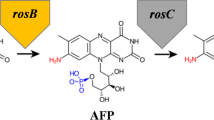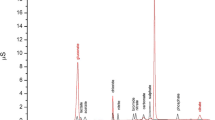Summary
Two new flavin compounds (X and Y) were found as metabolites of Schizophyllum commune, a Basidiomycete, producing a larger amount of L-malate through CO2-fixing process such as reductive carboxylation of phosphoenolpyruvate coupled with glyceraldehyde-3-phosphate under aerobic conditions. These two flavins were named ‘Schizoflavin (SF)’ after Schizophyllum, and X and Y were tentatively called SF1 and SF2, respectively. By using an enzymic system, SF2 was demonstrated to be a direct precursor of SF1, being formed from riboflavin.
Experiments were designed to obtain information about the relationship between SF and L-malate production in the mold. The conversion yield of SF from riboflavin was found to correspond to the level of L-malate-producing activity of the strains under aerobic conditions, where a stimulation of L-malate accumulation by SF1 was observed. Enzymic studies of mycelial homogenate of the mold showed. that SF1 did not stimulate the degradation of L-malate, although FAD did markedly so to form pyruvate.
SF was found not only to be distributed in all strains of S. commune, so far as tested, but also to be present in edible Basidiomycetes containing Agaricus bisporus and some uncharacterized Basidiomycetes.
SF1 was isolated, crystallized and identified as 7,8-dimethyl-10-(2,3,4-trihydroxy-4-carboxybutyl)isoalloxazine, and SF2 was identified as 7,8-dimethyl-10-(2,3,4-trihydroxy-4-formylbutyl)isoalloxazine. SF1 and SF2 were designated vitamin B2-acid and vitamin B2-aldehyde, respectively.
The vitamin activity of B2-aldehyde was proved by the bioassay using Lactobacillus casei. Reduction of B2-aldehyde to riboflavin was demonstrated by the cell-free extract of L. casei.
Vitamin B2-aldehyde-forming enzyme was isolated and shown so far to be a novel enzyme which is specific for riboflavin. α-NAD+, β-NAD+, α-NADP+, β-NADP+, FMN, FAD, and cytochrome c do not serve as electron acceptors for the enzyme, whereas 2,6-dichlorophenolindophenol, phenazine methosulfate, and methylene blue do so. However, NADPH-dependence of the enzyme and O2 requirement have been elucidated in the presence of Cu2+. The enzyme reaction was inhibited by α-tocopherol.
It was suggested that the over-production of L-malate through a reductive CO2-fixing process under aerobic conditions was due to FAD deficiency caused by vitamin B2-acid and vitamin B2-aldehyde formation because of the depression of pyruvate catabolism and L-malate degradation that require FAD, and due to the activity of vitamin B2-acid itself.
Similar content being viewed by others
Abbreviations
- FR:
-
free riboflavin
- SF:
-
schizoflavin
- SF1 or B2-acid:
-
7, 8-dimethyl-10-(2,3,4-trihydroxy-4-carboxybutyl)isoalloxazine
- SF2 or B2-aldehyde:
-
7,8-dimethyl-10-(2,3,4-trihydroxy-4-formylbutyl)isoalloxazine
- DCIP:
-
2,6-dichlorophenolindophenol
References
Tachibana, S., 1961. J. Ferment. Technol., 39: 696.
Tachibana, S., 1964. Hakko Kyokai Shi, 22: 210–217.
Tachibana, S., 1968. Hakko Kyokai Shi, 26: 244–255.
Tachibana, S., 1969. Kogyo Kagaku Zasshi, 72: 461–464.
Tachibana, S., 1969. Mushroom Science, VII, pp. 273–280.
Tachibana, S., 1971. Trans. Mycol. Soc. Japan, 12: 184–195.
Tachibana, S. and Murakami, T., 1975. Hakko Kyokai Shi, 33: 311–316.
Tachibana, S., 1967. J. Ferment. Technol., 45: 436–441.
Tachibana, S. and Murakami, T., 1974. J. Ferment. Technol., 52: 353–359.
Tachibana, S., Shiode, J. and Hanai, T., 1967. J. Ferment. Technol., 45: 1130–1138.
Tachibana, S., 1972. J. Vitaminol., 18: 210–212.
Tachibana, S. and Murakami, T., 1975. J. Nutr. Sci. Vitaminol., 21: 61–63.
Tachibana, S., Murakami, T. and Ninomiya, T., 1975. J. Nutr. Sci. Vitaminol., 21: 347–353.
Tachibana, S. and Murakami, T., 1980. In: Methods in Enzymology (McCormick, D.B. and Wright, L.D., editors) Vol. 66 (part E), pp. 333–338, Academic Press, New York.
Tachibana, S. and Oka, M., 1981. J. Biol. Chem., 256: 6682–6685.
Tachibana, S. and Oka, M., 1980. J. Nutr. Sci. Vitaminol., 26: 419–426.
Tachibana, S. and Oka, M., 1982. J. Nutr. Sci. Vitaminol., 28: 335–342.
Tachibana, S., Oka, M., Kato, Y., Kida, Y. and Kido, T., 1981. J. Nutr. Sci. Vitaminol., 27: 67–69.
Crammer, J.L., 1948. Nature, 161: 349–350.
Tachibana, S., 1971. In: Methods in Enzymology (McCormick, D.B. and Wright, L.D., editors) Vol. 18 (part B), pp. 413–416, Academic Press, New York.
Tachibana, S., 1961. J. Vitaminol., 7: 294–298.
Tachibana, S., 1969. Vitamins, 40: 50–52.
Tachibana, S. and Katagiri, H., 1955. Vitamins, 8: 309–314.
Fukamachi, C. and Sakurai, Y., 1954. Vitamins, 7: 939–942.
Tachibana, S. and Murakami, T., 1974. J. Ferment. Technol., 52: 511–516.
Nossal, P.M., 1951. Biochem. J., 49: 407–413.
Patton, J. and Reeder, W., 1956. Anal. Chem., 28: 1026–1028.
Murakami, T., 1975. In: A Thesis for the Degree of Doctor of Engineering at Ritsumeikan University, pp. 104–107.
Meister, A. and Abendschein, P.A., 1956. Anal. Chem., 28: 171–173.
Friedemann, T.E. and Haugen, G.E., 1943. J. Biol. Chem., 147: 415–442.
Tachibana, S., 1973. Vitamins, 47: 328.
Tachibana, S., Murakami, T. and Oka, M., 1974. Mushroom Science, IX (Part 1), pp. 761–769.
Whitby, L.G., 1953. Biochem. J., 54: 437–442.
Allen, R.J.L., 1940. Biochem. J., 34: 858–860.
Nakamura, M., 1950. J. Arg. Chem. Soc. Japan, 24: 1–5.
Lassaigne, M., 1843. C. R. Acad. Sci., 16: 387.
Hahn, F.L., 1945. Ind. Eng. Chem., Anal. Ed., 17: 199–200.
Feigl, F., 1954. In: Spot Tests, Vol. II, pp. 170, Elsevier, Amsterdam.
Feigl, F., 1954. In: Spot Tests, Vol. II, pp. 153, Elsevier, Amsterdam.
Tachibana, S., Oka, M., Tamura, H., Kamei, A., Mukai, H., Kanbayashi, C. and Shioiri, I., 1979. J. Nutr. Sci. Vitaminol., 25: 361–366.
Robert, E.C. and Snell, E.E., 1946. J. Biol. Chem., 163: 499–509.
Davis, B.J., 1964. Ann. N.Y. Acad. Sci., 121: 404–427.
Tachibana, S. and Oka, M., 1977. Vitamins, 51: 307.
Tachibana, S. and Oka, M., 1981. Vitamins, 55: 345.
Packer, J.E., Slater, T.F. and Willson, R.L., 1979. Nature, 278: 737–738.
Tachibana, S., Shiode, J. and Nishiuchi, H., 1967. J. Ferment. Technol., 45: 426–431.
Author information
Authors and Affiliations
Rights and permissions
About this article
Cite this article
Tachibana, S., Murakami, T. Metabolism of riboflavin in Schizophyllum commune . Mol Cell Biochem 51, 149–160 (1983). https://doi.org/10.1007/BF00230401
Received:
Issue Date:
DOI: https://doi.org/10.1007/BF00230401




